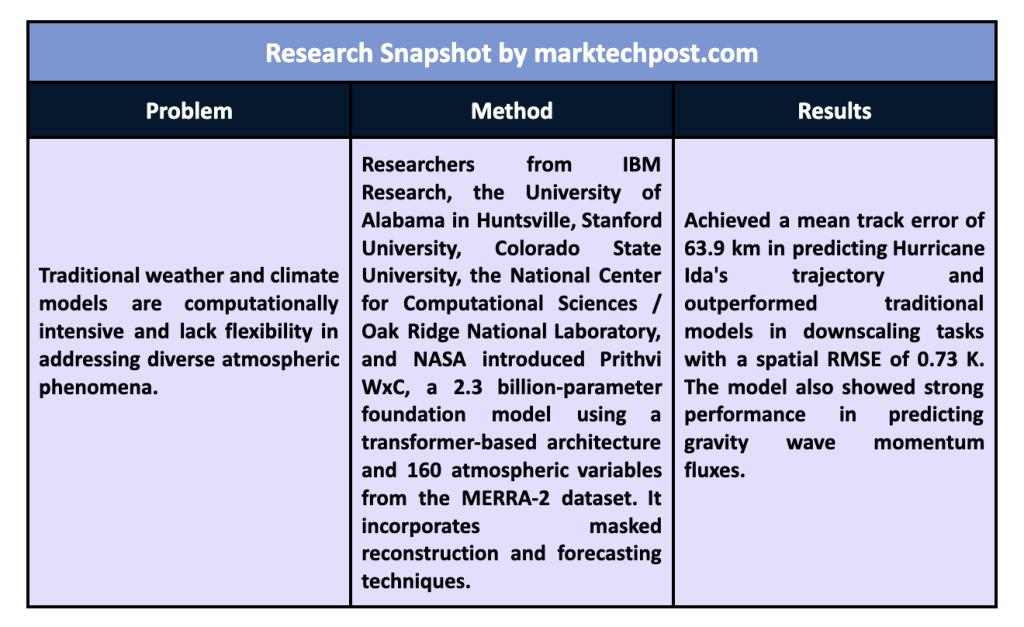Local weather and climate prediction has skilled speedy developments via machine studying and deep studying fashions. Researchers have began to depend on synthetic intelligence (AI) to boost predictions’ accuracy and computational effectivity. Conventional numerical climate prediction (NWP) fashions have been efficient however require substantial computational assets, making them much less accessible and tougher to use at bigger scales. In the meantime, deep studying fashions can seize advanced patterns and relationships inside the environment utilizing considerably fewer computational assets. This paradigm shift permits researchers to develop extra scalable and versatile fashions, facilitating predictions important for each short-term climate forecasting & long-term local weather modeling.
A basic downside in climate and local weather forecasting is the necessity for conventional fashions to seize non-linear atmospheric processes, particularly at finer resolutions. The dearth of a unified mannequin that concurrently addresses numerous use circumstances, reminiscent of regional climate predictions, excessive occasion forecasting, and local weather influence evaluation, poses a major problem. Additionally, there’s a want for fashions that may work successfully throughout totally different spatial and temporal scales. This hole is additional highlighted when coping with localized excessive occasions, which require high-resolution knowledge that many fashions wrestle to course of with out incurring excessive computational prices. Thus, creating a single, large-scale AI mannequin that addresses a number of forecasting challenges can considerably enhance present approaches.
Present deep-learning fashions for atmospheric sciences, like FourCastNet, Pangu, and GraphCast, are largely designed for particular forecasting duties. These fashions deal with points reminiscent of near-term forecasting however want extra flexibility for a broader vary of purposes. Moreover, most of those fashions make the most of task-specific architectures and goals, limiting their means to carry out underneath numerous forecasting situations, particularly in long-term predictions or advanced local weather modeling duties. Consequently, these fashions, whereas superior, typically want extra generalizability for complete local weather analysis.
Researchers from IBM Analysis and NASA have launched Prithvi WxC, a 2.3 billion parameter basis mannequin for climate and local weather forecasting. The Prithvi WxC mannequin incorporates 160 variables from the Fashionable-Period Retrospective Evaluation for Analysis and Purposes, Model 2 (MERRA-2), a high-resolution dataset overlaying international atmospheric situations. This mannequin employs a state-of-the-art encoder-decoder transformer-based structure, permitting it to seize native and international dependencies within the atmospheric knowledge effectively. Utilizing a transformer mannequin facilitates dealing with long-range dependencies within the knowledge, making it potential to mannequin advanced atmospheric interactions at numerous scales, from native to international.
Prithvi WxC’s core structure contains a mixture of native and international consideration mechanisms that allow it to course of massive token counts, successfully capturing spatial and temporal patterns within the enter knowledge. It additionally employs a combined goal operate that integrates masked reconstruction and forecasting duties. This distinctive strategy permits the mannequin to generalize nicely throughout totally different purposes, starting from autoregressive rollout forecasting to estimating excessive climate occasions. Additionally, the mannequin incorporates a pretraining part with 25 encoder and 5 decoder blocks, using superior AI methods reminiscent of masked autoencoding and variable lead-time prediction. The mannequin’s flexibility is additional enhanced by its means to include further tokens from off-grid measurements throughout fine-tuning, making it adaptable for numerous downstream purposes.
In the course of the analysis, Prithvi WxC confirmed superior efficiency in a number of benchmarks. One of many highlights was its means to precisely predict the monitor and depth of Hurricane Ida, reaching a imply monitor error of simply 63.9 km in comparison with 201.9 km for different main fashions. The mannequin was additionally examined on downstream duties like downscaling, the place it demonstrated a outstanding spatial root imply sq. error (RMSE) of 0.73 Okay when predicting 2-meter air temperature, outperforming conventional strategies by an element of 4. Its capabilities prolong to gravity wave flux parameterization, the place it outperformed baseline fashions by efficiently predicting momentum fluxes within the higher troposphere.
Key Takeaways from the Analysis:
- Prithvi WxC is a 2.3 billion parameter basis mannequin incorporating 160 atmospheric variables.
- The mannequin makes use of a transformer-based structure with native and international consideration mechanisms.
- It achieved a imply monitor error of 63.9 km for Hurricane Ida, considerably outperforming different fashions.
- Prithvi WxC has proven a spatial RMSE of 0.73 Okay in downscaling duties, surpassing conventional strategies by 4.
- The mannequin’s distinctive coaching strategy integrates masked reconstruction and forecasting, making it adaptable to varied atmospheric purposes.
- Researchers have demonstrated its effectiveness in a number of downstream duties, together with excessive occasion prediction and gravity wave flux parameterization.

In conclusion, the event of Prithvi WxC signifies a major leap in climate and local weather modeling, offering a scalable and versatile answer that addresses the restrictions of present fashions. Its means to deal with a number of duties utilizing a unified structure positions it as a possible cornerstone for future developments in local weather science. The mannequin’s success throughout numerous benchmarks and its superior dealing with of advanced atmospheric interactions signifies that basis fashions like Prithvi WxC might revolutionize the best way climate and local weather predictions are made, enhancing accuracy and lowering computational prices.
Take a look at the Paper, Mannequin Card on Hugging Face, and GitHub Web page. All credit score for this analysis goes to the researchers of this undertaking. Additionally, don’t overlook to comply with us on Twitter and be part of our Telegram Channel and LinkedIn Group. In case you like our work, you’ll love our publication..
Don’t Neglect to hitch our 50k+ ML SubReddit
Need to get in entrance of 1 Million+ AI Readers? Work with us right here
Asif Razzaq is the CEO of Marktechpost Media Inc.. As a visionary entrepreneur and engineer, Asif is dedicated to harnessing the potential of Synthetic Intelligence for social good. His most up-to-date endeavor is the launch of an Synthetic Intelligence Media Platform, Marktechpost, which stands out for its in-depth protection of machine studying and deep studying information that’s each technically sound and simply comprehensible by a large viewers. The platform boasts of over 2 million month-to-month views, illustrating its recognition amongst audiences.




